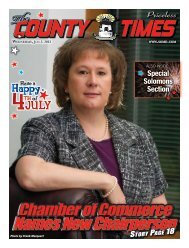christmas behind bars - County Times - Southern Maryland Online
christmas behind bars - County Times - Southern Maryland Online
christmas behind bars - County Times - Southern Maryland Online
Create successful ePaper yourself
Turn your PDF publications into a flip-book with our unique Google optimized e-Paper software.
13 Thursday, December 22, 2011<br />
The Calvert Gazette<br />
Editorial<br />
Stories Highlight True<br />
Meaning of Christmas<br />
Today’s cover stories highlight a local jail and street ministry’s work in the Calvert<br />
Detention Center and the story of a woman teaching among <strong>Maryland</strong>’s toughest<br />
criminals. A common theme ran through their stories, the need for more programs<br />
to help at risk youth and to educate those already in prison. Although these<br />
stories are running together, they were actually conceived and people interviewed<br />
months apart. The decision to run these stories this week came two months later.<br />
In November the Calvert Gazette ran stories about local programs and organizations<br />
providing the very services mentioned in the featured stories. In fact, for the<br />
second year in a row, Calvert <strong>County</strong> has won the 100 Best Communities for Young<br />
People given by America’s Promise Alliance in recognition for programs targeting<br />
the high school drop-out rate, and coming together as a community to identify and<br />
address gaps in services to the youth.<br />
According to a report from March 2010 from the Department of Legislative<br />
Services Office of Policy Analysis, Calvert’s Detention Center averaged 230 inmates<br />
a day in its population. So one can assume, if the prisoners quoted in the featured<br />
stories story are an accurate reflection of what others in their situation would<br />
say, there appears to be a gap between the services offered and their target audience.<br />
So the answer can’t be as simple as providing more programs, spending more<br />
on education and rehabilitation or working with at risk populations. While these are<br />
necessary and great goals and should be done, there has to be a different and better<br />
answer.<br />
Merle Morrow said her spiritual director told her, “The way you change systems<br />
is by changing hearts.”<br />
As mentioned above, there appears to be a gap between what many in society<br />
are trying to provide and what others in society are receiving. How can the gap be<br />
filled? Maybe the answer is in what seemed purely coincidental, the choice to run<br />
the featured stories this week. The front cover photo is of Chaplin John Graham<br />
passing out Christmas cards and “giving an individual word to each of the inmates.”<br />
Over a century ago, on March 12, 1905 on page four of the Washington Post<br />
the headline read “Fervor of Religious Revival Stirs Two Continents.” The headline<br />
took up eight column spaces. The accompanying the story related information<br />
about 100,000 confirmed conversions in Wales and unnumbered conversions<br />
in London and a half a dozen American cities. The Post “proclaimed that the earth<br />
would become heaven if people would only “realize God” and follow the Golden<br />
Rule,” according to authors Collin Hansen and John Woodbridge in A God-Sized<br />
Vision: Revival Stories that Stretch and Stir.<br />
The story further stated that in Wales, “the police found no crime to investigate<br />
amid ‘an almost complete realization of the Golden Rule in all affairs of daily life.’”<br />
The origin of Christmas comes from the Christian story of God stepping down<br />
from heaven to take the form of a baby, later to grow into the man of Jesus. Whether<br />
you believe that Jesus was both fully man and fully God is up to you. But that is<br />
what Christians profess. One international ministry which teaches about Jesus uses<br />
the illustration of two cliffs separated by a bottomless pit – man is on one cliff and<br />
God is on the other. “How can man get across to God?” The ministry draws a bridge<br />
that takes the form of a cross, the place upon which Jesus died for proclaiming his<br />
message.<br />
Jesus’ message was about changing hearts. One at a time. He said. “There is no<br />
greater love than this that a man lay down his life for another.” He had two meanings<br />
in mind when he said this. First he foretold of his dying for his people. But he<br />
also meant people laying down their lives daily for others. Imagine if everyone laid<br />
down time spent watching TV, reading the Internet Social Networks, working extra<br />
hours to get ahead … and invested that hour or so a week in developing relationships<br />
with at risk youth, teaching a job skills class in prison or mentoring an inmate who<br />
just got out of prison.<br />
The nation was originally founded by men and women who believed in the<br />
message of Jesus, the reason for Christmas. As the nation moves further away from<br />
the lessons taught, the prisons fill up. Coincidence? While the Gazette doesn’t have<br />
space to provide all the prisoner’s responses to questions asked, it was interesting to<br />
note that the majority wrote about getting back to teaching church, morals, respect,<br />
spirituality, and sanctity of life as solutions for keeping the prison population down.<br />
The message of the Christmas season boils down to this: When God considered<br />
the struggles of humanity he did not just resource a project to help out. He laid<br />
aside the comforts of heaven and came down to earth. Jesus lived among his people,<br />
personally touching them at their point of greatest need. In addition to the resources<br />
of governments and charities, society needs more people like Chaplin John Graham<br />
and Merle Morrow who followed Jesus’ example willingly laying aside their comforts<br />
to touch those in need. Not just as an act of holiday kindness, but throughout<br />
the year.<br />
When is a Birthday<br />
Cake an Ethics<br />
c<br />
Violation?<br />
By Susan Shaw<br />
Calvert <strong>County</strong> Commissioner, 2nd District<br />
Recently, the criminal<br />
cases of former<br />
Prince Georges <strong>County</strong><br />
Executive Jack Johnson<br />
and his wife, Councilmember<br />
Leslie Johnson,<br />
have been in the news.<br />
How did the so-called<br />
“pay to play” culture of<br />
corruption develop in<br />
Prince George’s <strong>County</strong><br />
and then continue for so<br />
long?<br />
At the very beginning of the problem someone<br />
should have filed an ethics complaint before the behavior<br />
escalated to the criminal level. Is this what<br />
would have happened in Calvert <strong>County</strong>? I hope<br />
so.<br />
Calvert <strong>County</strong> has an Ethics Commission<br />
comprised of citizen members appointed by the<br />
Board of <strong>County</strong> Commissioners (BOCC). There<br />
is also a state Ethics Commission, from whom the<br />
local Ethics Commission can seek advice. The role<br />
of the Calvert <strong>County</strong> Ethics Commission (CCEC)<br />
is first to provide advice, training, and counsel to<br />
<strong>County</strong> employees and <strong>County</strong> elected officials to<br />
try to prevent any ethics issues. When asked for<br />
advice, the CCEC may issue an advisory opinion<br />
that is available to other employees who may have<br />
the same or similar questions. Employees, elected<br />
officials, and many Board and Commission members<br />
are required to fill out a financial disclosure<br />
statement at the beginning of each calendar year.<br />
The CCEC reviews these forms and follows up to<br />
clarify any apparent conflict of interest.<br />
In the last <strong>Maryland</strong> Legislature, an updated<br />
state ethics bill was passed with new, strengthened<br />
requirements that counties pass similar local legislation.<br />
Our local CCEC had already been working<br />
on a re-write of our local ethics code. Using the<br />
Publisher<br />
Thomas McKay<br />
Associate Publisher Eric McKay<br />
Editor<br />
Sean Rice<br />
Graphic Artist Angie Stalcup<br />
Office Manager Tobie Pulliam<br />
Advertising<br />
sales@somdpublishing.net<br />
Email<br />
info@somdpublishing.net<br />
Phone 301-373-4125<br />
Staff Writers<br />
Guy Leonard<br />
Sarah Miller<br />
Corrin Howe<br />
Contributing Writers<br />
Joyce Baki<br />
Keith McGuire<br />
Law Enforcement<br />
Government, Education<br />
Community, Business<br />
to the<br />
Editor<br />
LETTERS<br />
ommissioners<br />
guidance of the new state ethics code,<br />
the CCEC has presented some draft ethics<br />
ordinances to the BOCC.<br />
I have been disappointed to learn that the<br />
updated state code still sets the gift limit for reporting<br />
at $20, which I see as being too low. If<br />
someone bakes a fellow employee a birthday cake,<br />
that could cake could be worth more than $20. The<br />
employee must report all gifts that have a value of<br />
more than $20.<br />
I see the first role of the CCEC as being to address<br />
conflicts of interest and perceived conflicts<br />
of interest. What is the difference between an<br />
actual and a perceived conflict of interest? Very<br />
little. If it looks like self-dealing, it probably is<br />
self-dealing. The second role is to address undue<br />
influence. Judging undue influence can be tricky,<br />
because perhaps the individual just made an error<br />
in judgment or a mistake that benefits a particular<br />
party without any undue influence from anyone or<br />
any benefit to self.<br />
If the CCEC suspects a bigger problem that<br />
might rise to the level of criminal behavior, they<br />
refer their suspicions to the State’s Attorney’s Office<br />
for further investigation.<br />
As part of the current update of the Calvert<br />
<strong>County</strong> Ethics Code, the CCEC requested subpoena<br />
power. Later, they modified the request to<br />
one for summons power. This request is controversial.<br />
An appointed Ethics Commission is not<br />
a court. It turns out that, so far, no one has ever<br />
failed to appear at a CCEC inquiry when requested<br />
to do so. However, in some instances, individuals<br />
have failed to bring requested documents and have<br />
declined to answer some questions. That happens<br />
even in court. Should this type of judicial power<br />
be extended to the appointed citizens of the CCEC?<br />
What about due process and privacy rights? Stay<br />
tuned as the BOCC continues to weigh the pros and<br />
cons on the way to a new Ethics Code.<br />
Calvert Gazette<br />
P. O. Box 250 . Hollywood, MD 20636<br />
c<br />
orner<br />
The Calvert Gazette is a weekly newspaper providing news and information for the residents of<br />
Calvert <strong>County</strong>. The Calvert Gazette will be available on newsstands every Thursday. The paper is<br />
published by <strong>Southern</strong> <strong>Maryland</strong> Publishing Company, which is responsible for the form, content, and<br />
policies of the newspaper. The Calvert Gazette does not espouse any political belief or endorse any<br />
product or service in its news coverage. Articles and letters submitted for publication must be signed<br />
and may be edited for length or content. The Calvert Gazette is not responsible for any claims made<br />
by its advertisers.

















